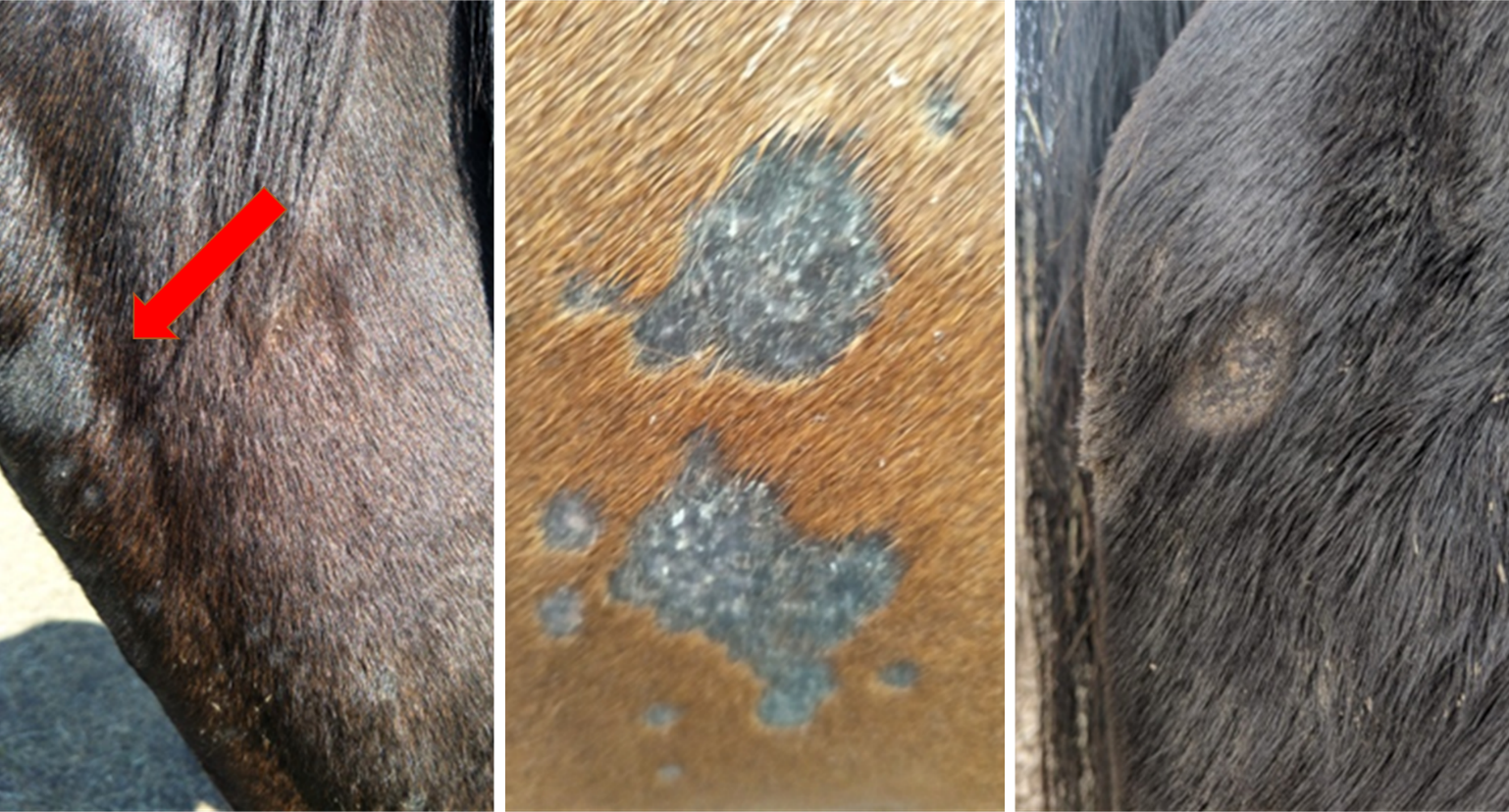 Ringworm, or dermaphytosis, is a highly infectious and contagious fungal disease of the skin that can affect most animals, including horses and humans.
Ringworm, or dermaphytosis, is a highly infectious and contagious fungal disease of the skin that can affect most animals, including horses and humans.
There are many different fungal organisms that can cause ringworm. Participants are required to report horses they suspect may have a ringworm infection under the Australian Harness Racing Rule 104. Horses exhibiting signs of ringworm infection will not be allowed entry at Victorian harness racing facilities.
Horses suspected of ringworm infection will not be allowed to race until cleared by a specific veterinary clearance certificate.
The veterinary certificate must confirm:
- multiple negative skin scrapings over a 10-day period
- OR a negative skin biopsy from the edge of the lesion
- OR completion of a 28-day quarantine period with appropriate treatment with no evidence of new lesions.
Horses exhibiting signs of ringworm infection will be refused entry at harness racing tracks in Victoria.
What does ringworm look like?
Ringworm may start as one or two small patches of hairless, dry scaly or pimply skin. They are not always circular. If left untreated the lesions will grow quickly into large irregular areas of broken hairs and blisters with scabby or flaky skin underneath. Ringworm will often start where the skin is being stressed, such as where the harness rubs.
How do I treat ringworm?
Your vet will advise on specific treatment protocols for your horse. The following are general guidelines for treating ringworm:
- Wear disposable gloves and overalls when handling infected horses and their equipment.
- Completely isolate any horses showing clinical signs of possible ringworm infection immediately.
- Do not allow infected horses, equipment (including harness and sulkies), feed and water containers, fencing to contact any other horse. Staff must wear protective equipment and decontaminate after contact with infected horses.
- Do not groom or clip infected horses as this will spread fungal spores.
- Gently remove any scabby lesions with a disposable scrub sponge or toothbrush. Dispose of flakes, scrubbing tool and hair as biologically hazardous material.
- Apply a suitable fungicidal wash over the entire horse (avoiding contact with eyes, mouth, nose, and genitals) in accordance with manufacturer's instructions two to three times a week. Recommended products include Imaverol, Pevidine, Malaseb and Betadine. The washes must remain on the horse's body for ten minutes. Rinsing the horse with an accelerated hydrogen peroxide solution (1:20 dilution) after the anti-fungal wash increases the action against ringworm.
- Allow the infected horse out into sunlight as much as possible as the ultraviolet light kills fungal spores.
- Avoid rugging infected horses.
- All infected equipment (including harness, boots, saddle cloths, towels etc) and facilities should be treated with a fungicide.
Your veterinarian may recommend oral griseofulvin powder (antifungal) if the infection is severe. It must be used in conjunction with whole body antifungal washes.
Some veterinarians also recommend administering intravenous sodium iodide (20 per cent) although there is little evidence that this treatment protocol is effective against ringworm. Both these agents could cause abortion in pregnant mares.
How do I prevent ringworm infection?
Ringworm is a complex disease process between fungi and the individual's immune system. Complete prevention of ringworm outbreaks is not always possible, but the following guidelines will reduce the risk:
- Implement a three-week quarantine process for newcomers into the stable. Incubation for ringworm is between two to four weeks.
- Ringworm is commonly spread by handlers and equipment. Staff should be trained in hygiene and disinfection processes. Regularly washing hands and disinfecting equipment and facilities is an important part of infection control
- Apply suitable fungal disinfectants on equipment as part of routine cleaning. Virkon S and F10 are two products that can be safely used on harness.
- Bleaching agents containing hypochlorite are a cost-effective way to disinfect buckets, stable forks and shovels, and grooming equipment.
- Rugs should be laundered and hot air dried between horses.
- Apply an anti-fungal spray disinfectant on the inside of transport vehicles and tyres, stable floors and walls, and stable equipment regularly.
- Fungal spores in dirty bedding and water food containers remain infectious for months to years. Clean stalls, yards and containers regularly.
- Cross-infection can occur between a horse and other animals such as cows or cats, either through animal-to-animal contact or, more commonly, from infected environments in shelters or equipment.
- Make careful examination of each horse part of daily management and act quickly if a suspicious lesion is identified.
Conclusion
Ringworm is a contagious fungal infection that can affect horses and humans. It is a notifiable condition under Australian Harness Racing rules and horses exhibiting signs of ringworm infection will not be allowed entry at Victorian harness racing facilities. Ringworm infection occurs through a combination of exposure and vulnerability. Effective treatment is time consuming and challenging. Diligent quarantine and hygiene practices will reduce the incidence of this disease in standardbred horses.
